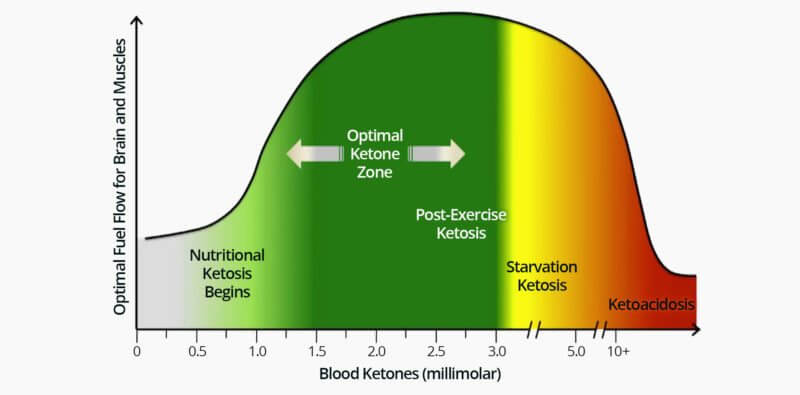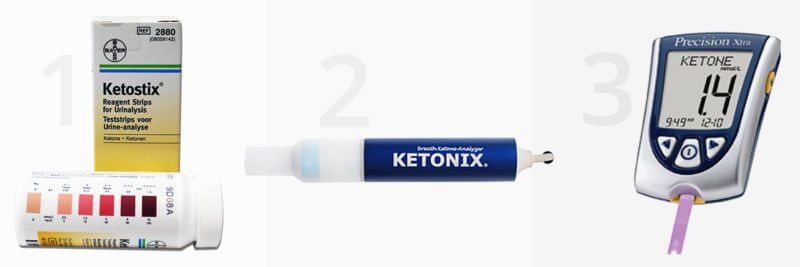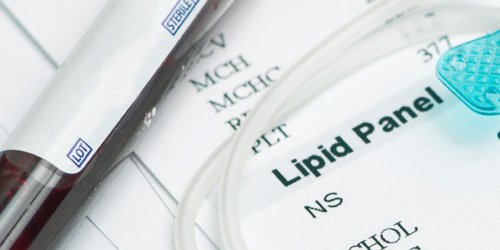Click here to get this post in PDF
History of the ketogenic diet

Ketogenic diet is a low-carbohydrate diet, high-fat, moderate protein eating plan. I will emphasize Moderate Protein. This is where it differs from the Atkins diet. Many providers confuse ketoacidosis with nutritional ketosis. You can see from the graph above that they vary by a factor of 10. Also ketoacidosis occurs when there is high glucose and ketones together. This does not happen in nutritional ketosis. It was used in the 1920’s to treat kids with epilepsy. The ketones that are produced on this diet have an amazing affect on the nervous system. Today bodybuilders are using this diet to eliminate any fat on their bodies. This diet forces the body to switch from burning carbohydrates to burning fat. When the body does not have any glucose available it uses the liver to convert fats to fatty acids and ketone bodies. Our bodies are designed to burn on these fuels through evolution. Ketogenic diet today is being used to treat pediatric epilepsy patients that are failing drug therapy. Children on a keto diet have had positive results in reducing the number of seizures. This post will be focusing on a ketogenic diets as a lifestyle choice to maximize your weight lost and improve your insulin resistance.
What is ketosis

The purpose of a ketogenic diet is to put your body into a state of ketosis. Ketosis is when your body is burning fat for fuel instead of using glucose. What you see in the picture above are three ways to measure and see if you are in ketosis. Ketones are the water soluble fats that can cross the blood brain barrier and are a very clean source of energy. Most of us use glycolysis for energy. This is when the body uses glucose for energy and it is not a clean source of energy. The majority of the cells in our body can use both ketone bodies and glucose for fuel. Your brain and your heart actually prefer to burn ketones as it is a more efficient fuel. Red blood cells are one of the exceptions because they do not have mitochondria and therefore have to use glucose for fuel. When we eat excess carbohydrates we have too much insulin is production which blocks the release of fat for fuel. When we are in ketosis our bodies uses the fat reserves for fuel .
Ketogenic Diet Macros

A ketogenic diet is low in carb, moderate in proteins and high in fat. I emphasize this is a high fat diet. Eating between 30-50 grams of carbohydrates per day would meet this requirement and keep your blood sugar low. This can be really tough for a lot of people. The Standard American Diet(SAD) is full of carbs! The SAD has led to out of control obesity, diabetes, alzheimers and many other chronic diseases. The main types of Ketogenic diets are the targeted keto diet (TKD) and the cyclical keto diet (CKD). People who do intense workouts should eat carbs right before and right after the workout and use the targeted keto diet approach. Cyclical keto diet cycles in and out of ketosis and is probably the best diet for long term use. This is what I use and teach in the 22 Day Weight Loss Program. Your intake of fats should be between 60-70% of your daily calories, proteins based on your lean body mass, and carbohydrates no more than 50 grams daily. Some people will have to be below 20 grams of carbs to get into ketosis. These are the people that can’t even use net carbs, they have to count everything. Everyone is different.
Problems with a Ketogenic Diet

Every diet has issues and the ketogenic diet is no exception. Some people believe this diet is all about butter, bacon, and meat. You still need your vegetables ! If you do not eat vegetables you can become deficient in micronutrients such as thiamin, folate, calcium, potassium and magnesium. Taking a daily multivitamin and supplementing your electrolytes is a good idea. I actually do a bone broth with a half a teaspoon of Himalayan salt everyday. This is a good way to prevent the keto flu. The good news is your cholesterol profile should improve while on this diet. Specifically , your HDL will go up and your triglycerides should come down. Some other good news is that you will lose weight. You should always be tracking your numbers when you make a lifestyle change. Labs, weight, how you feel, how much exercise your getting in , and sleep. I really like using a fitbit to help with this. There are many variations to the keto diet and you should consult your primary care provider to make sure that you don’t have health issues that would cause problems on this diet.
If you want to see what someone on a ketogenic diet eats for a week I tracked myself for a week. Everything I ate and my blood values are written down in this post. You can check out my keto week here.
The Loveland Medical Clinic does weight management programs and runs a program that is partially based on the ketogenic diet. If you are interested in losing weight check out our page .
| Additional reading: | |
| Title: | HTML: |
| Keto diet , ketogenic diet 101 and medium chain triglycerides | |
| Keto diet and blood sugar levels | |
| keto diet day for women | |
| Joe Rogan on diet ketogenic and alzheimer s disease | |
| classic ketogenic diet vs low carb diet and insulin levels | |
| Benefits of Keto diet and polycystic ovary syndrome | |














Leave a Reply
You must be logged in to post a comment.